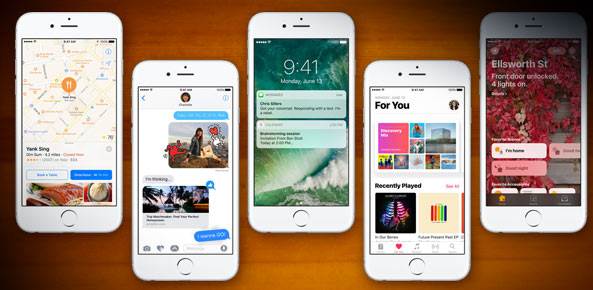
As mobile usage increases, we’ve grown to rely on visuals such as emojis, GIFs and stickers to better articulate the feelings, thoughts and tone behind the words we type. This visual language has moved well beyond simple entertainment — it’s becoming a language that many are becoming fluent in and turn to in everyday conversations.
Apple’s upcoming iOS 10 launch will be a seminal moment in this evolution: Making visual expression within iMessage simple and powerful on one billion Apple devices across the world, while posing unique opportunities (and threats) for the industry and accelerating the shift from public to private sharing.
Apple’s Messages platform will accelerate the larger movement of messengers into the “new browser,” further expanding our language from text and pictures to GIFs, videos, stickers and dynamic embeds.
With iOS 10, people will have access to apps within iMessage that allow them to seamlessly add a visual layer to the messages they send — everything from disappearing text to animated GIFs, stickers and videos. These apps are invoked natively from within iMessage, and can tap into many of the same OS-level capabilities as an app that sits on your homescreen. Beyond exposing a tray of app icons inside iMessage, the platform enables users to send fully programmable apps (“MSMessages”) that are embedded in iMessage conversations that, when tapped, invoke a fully programmable and dynamic screen.
Apple is not the first to introduce this type of platform; Kik launched one of the first HTML5 Messaging platforms back in 2013, and Facebook Messenger pioneered messaging platforms. However, Apple brings two unique powers to bear: It owns and operates the largest and most-used messenger in North America as well as the underlying operating system itself, putting the company in a strong position to dominate the industry.
As more people take their conversations from the public web into private conversations via messengers, there’s an enormous opportunity for a new category of services as well as a threat to products that rely on public sharing and the web. There’s significant friction in switching between a messenger and a web browser, which has led many to offer services within messengers. iOS 10 will take this a step further by making services available directly on top of messaging, either via keyboards or messaging apps.
Apple’s Messages platform will accelerate the larger movement of messengers into the “new browser,” further expanding our language from text and pictures to GIFs, videos, stickers and dynamic embeds. According to Apple’s Craig Federighi, iMessage is already the most-used application on iOS. We’re spending more and more time inside messengers, sharing privately, sharing ideas, thoughts and feelings. While people use the web as a utility to find information, browse the news or entertain themselves, they are increasingly turning to messengers to communicate. Messaging-first services will have the best understanding of your thoughts, feelings and emotions. Unlike the web, which is organized by hyperlinks, our messengers organize information by the people we talk to with visual, interactive applications floating between us.
Unlike companies that dominate the web, services built on top of messaging will be built around communication-focused use cases — a new center of gravity will form around your emotional graph.
This creates an opportunity for developers to build revenue-generating businesses on the platform. Apple’s revenue share (70/30) is the same on the Messages apps as it is on homescreen apps. iOS 10 developers can tap much of the same underlying ad infrastructure available in homescreen apps – all with OS-level stability. In the same way that public market investors richly value apps built on top of the iOS homescreen ($350 billion Facebook, $18 billion Snapchat, $9 billion Line), we’ll see a new crop of companies emerge on top of messaging platforms.
The stability of an operating system-level platform (as opposed to companies relying on SEO or Facebook’s News Feed for traffic) will give these companies an upper hand in succeeding and going public. Unlike companies that dominate the web, services built on top of messaging will be built around communication-focused use cases. A new center of gravity will form around your emotional graph, attracting brands and media to create a new form of content best suited for emotional, visual expression.
While iOS 10 creates opportunities, it will also have an impact on other players in the industry, who will adjust their platforms in response to Apple’s move. While Google does not operate a messenger with the daily scale of iMessage, its recent Jibe acquisition makes it well-positioned to build a coalition of support for RCS, an evolution of MMS that could potentially offer a competitive messaging platform when combined with Android’s scale. In the meantime, the bot-based ecosystems from Kik, Facebook Messenger and Telegram will continue to grow, creating a healthy and competitive platform ecosystem.
The hidden iOS 10 browser will look much different than the web browsers we’re familiar with today — the content we consume and the interactive applications floating between us will be shaped by our need to privately and visually express our full range of our emotions.
© 2016 Re/Code under contract with NewsEdge. -.







